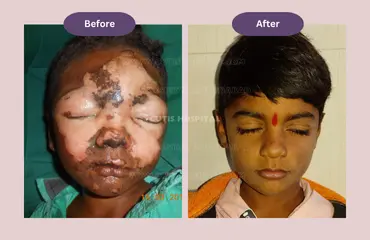Pediatric burn is a top reason for accidental injury and death among infants, children, and adolescents. Due to exposure to heat or hot liquids, skin and tissues can get scalded or severely burnt. It’s not only painful but also emotionally stressful for the child and the family. However, with suitable Pediatric burn treatment plan healing and recovery occurs in a few days or weeks.
Pediatric burn is injury to the child’s skin due to exposure to heat, flame, and chemicals. It affects millions of children worldwide, and to help them heal Pediatric burn treatment that involves surgery, post-operative care, and counselling.
First-Degree Burns (Superficial): These burns are shallow and mild as the burn is limited to the skin’s top layer. The skin turns red, dry without blisters, mildly swollen, and painful. Healing takes up to 6 days, while the dead skin may peel within 2 days.
Second-Degree Burns (Partial Thickness) – This Pediatric burn involves damage to second layer of skin (dermis). The burnt area turns red, swollen, blistered, and painful. Healing takes up to 3 weeks or longer depending on depth of the burn.
Third-Degree Burns (Full Thickness): This is a life-threatening burning as all skin layers are damaged along with tissues, muscles, and nerve endings. The burnt area appears dry, leathery, charred. No pain is felt as the nerves are damaged. Often, patients need to undergo skin grafts surgery, and healing takes several months.
Pediatric burn treatment involves.
Pediatric burn if not healed properly may lead to the following complications.
To reduce the risk of commonly occurring Pediatric burn following preventions should be considered.
Our team of Pediatric burn surgeons, medical staff, and counsellors treat all types of burns- chemical, flame, and electrical burns. We have well-equipped operation theater for surgery and innovative medical procedures to delicately heal children and help them return to their normal lifestyle.



Depending on the degree of burn, it can lead to itchy, red, less elastic, and painful skin. A scar can appear on the joints which makes movement of legs and arms difficult. If skin graft is done, the skin becomes sensitive to the sun.
Give your child pain medication to ease the irritation of itchy and burning skin. Constantly feed your child liquid and keep him/her calm.
Deeper burns tend to leave scars, while minor burns without blisters heal quickly and don’t leave a scar. However, sometimes blisters can leave a scar.
To minimize scarring, cover your child’s burn with sterilized bandages until completely healed and new skin begins to appear. Further, protect the area with sunscreen or UV clothing when out in the harsh sun.
Superficial Pediatric burns may heal within 3 weeks with suitable treatment and leave no mark or scar.
Deep burns will take weeks or months to heal, and skin grafting is advised for faster healing process. It will leave behind a scar.
Cutis Hospital is conveniently located in Ghatlodia, Ahmedabad, making it easily accessible via multiple modes of transportation. Below are the various ways you can reach our facility:
Sardar Vallabhbhai Patel International Airport: Located approximately 12.7 km from Cutis Hospital, offering convenient access for patients traveling from outside the city.
Chandlodiya Railway Station: Approximately 2.4 km from Cutis Hospital.
Ahmedabad Railway Station: Around 11 km from our center.
GSRTC:
Ahmedabad Central Bus Station (GSRTC): About 10.3 km from the hospital.
AMTS:
Bhuyangdev Cross Road Bus Stop: Just 500 meters from Cutis Hospital.
BRTS:
Bhuyangdev BRTS Bus Stop: Only 170 meters from our center.
We provide effective surgical and non-surgical treatments for all parts of the body. At Cutis Hospital, our cosmetic and plastic surgery team is committed to giving patients safe and high-quality care.